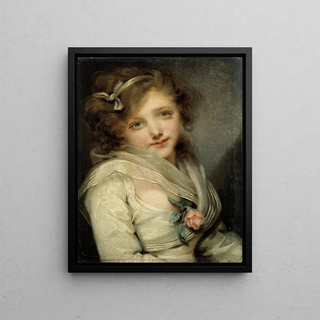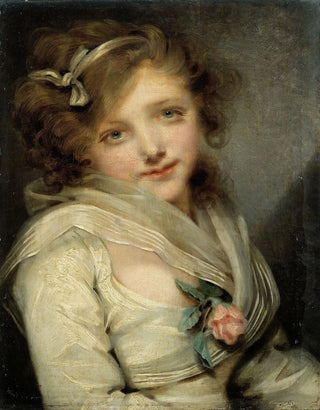Art print | Portrait of a young girl - Jean-Baptiste Greuze


View from behind

Frame (optional)
Portrait of a Young Girl - Jean-Baptiste Greuze – Captivating Introduction
The "Portrait of a Young Girl" by Jean-Baptiste Greuze is an iconic work of the 18th century, captivating through its grace and expressiveness. This painting, which evokes youthful beauty and innocence, is a true ode to youth, where every detail seems to breathe delicacy. The young girl's gaze, both dreamy and contemplative, draws the viewer into a universe where time appears to stand still. Through this art print, the artist manages to transcend mere facial features to evoke deep emotions, thus revealing the soul of his model. This portrait does not merely capture the appearance of a young woman; it tells a story, that of a moment frozen in eternity, where beauty and sensitivity meet.
Style and uniqueness of the work
Greuze's style is distinguished by meticulous attention to detail and mastery of light play. In the "Portrait of a Young Girl," the soft light caressing the protagonist's face creates a striking contrast with the shadow, adding an almost sculptural dimension to the piece. The colors, delicate and subtly nuanced, evoke an atmosphere of serenity and tenderness. The composition, meanwhile, is carefully orchestrated, with each element chosen to reinforce the emotion conveyed by the young girl's face. Greuze excels in depicting expressions, and here, he manages to capture a gentle melancholy, an introspection that resonates with anyone who gazes into his model's eyes. This portrait is a true testament to the art of emotion, where outer beauty blends with inner depth.
The artist and his influence
Jean-Baptiste Greuze, a prominent figure of the rococo movement, established himself through his unique approach to portraiture. Born in 1725, he evolved within an artistic context undergoing rapid change, where neoclassicism began to overshadow rococo style. Greuze capitalized on this transition, incorporating elements of realism into his works while preserving the lightness and grace characteristic of his era. His influence extends beyond

Matte finish

View from behind

Frame (optional)
Portrait of a Young Girl - Jean-Baptiste Greuze – Captivating Introduction
The "Portrait of a Young Girl" by Jean-Baptiste Greuze is an iconic work of the 18th century, captivating through its grace and expressiveness. This painting, which evokes youthful beauty and innocence, is a true ode to youth, where every detail seems to breathe delicacy. The young girl's gaze, both dreamy and contemplative, draws the viewer into a universe where time appears to stand still. Through this art print, the artist manages to transcend mere facial features to evoke deep emotions, thus revealing the soul of his model. This portrait does not merely capture the appearance of a young woman; it tells a story, that of a moment frozen in eternity, where beauty and sensitivity meet.
Style and uniqueness of the work
Greuze's style is distinguished by meticulous attention to detail and mastery of light play. In the "Portrait of a Young Girl," the soft light caressing the protagonist's face creates a striking contrast with the shadow, adding an almost sculptural dimension to the piece. The colors, delicate and subtly nuanced, evoke an atmosphere of serenity and tenderness. The composition, meanwhile, is carefully orchestrated, with each element chosen to reinforce the emotion conveyed by the young girl's face. Greuze excels in depicting expressions, and here, he manages to capture a gentle melancholy, an introspection that resonates with anyone who gazes into his model's eyes. This portrait is a true testament to the art of emotion, where outer beauty blends with inner depth.
The artist and his influence
Jean-Baptiste Greuze, a prominent figure of the rococo movement, established himself through his unique approach to portraiture. Born in 1725, he evolved within an artistic context undergoing rapid change, where neoclassicism began to overshadow rococo style. Greuze capitalized on this transition, incorporating elements of realism into his works while preserving the lightness and grace characteristic of his era. His influence extends beyond






